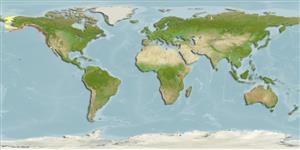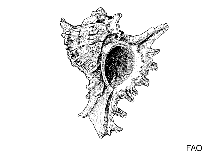Ceratostoma foliatum (Gmelin, 1791)
Leafy hornmouth| Native range | All suitable habitat | Point map | Year 2050 |

|
| This map was computer-generated and has not yet been reviewed. |
| Ceratostoma foliatum AquaMaps Data sources: GBIF OBIS |
Upload your photos
Google image | No image available for this species;
drawing shows typical species in Muricidae.
Google image | No image available for this species;
drawing shows typical species in Muricidae.
Classification / Names Common names | Synonyms | CoL | ITIS | WoRMS
Gastropoda | Neogastropoda | Muricidae
Environment: milieu / climate zone / depth range / distribution range Ecology
Benthic; depth range 0 - 60 m (Ref. 95344). Subtropical
Distribution Countries | FAO areas | Ecosystems | Occurrences | Introductions
Eastern Pacific and the Arctic: Alaska to California. Subtropical to boreal.
Length at first maturity / Size / Weight / Age
Maturity: Lm ? range ? - ? cm Max length : 9.0 cm SHL male/unsexed; (Ref. 865); common length : 8.0 cm SHL male/unsexed; (Ref. 312)
Short description Morphology
Description: Shell has spiral ridges. Has at least three prominent wing-like structures, worn off in older snails. Color is brown and white to creamy-white. Young snails have tooth-like projections on the lip of the shell (Ref. 312).
Occurs in the low intertidal zone. Uses the radula to bore through the calcareous shells of its prey (clams, mussels, and barnacles; Ref. 312) (Ref. 312).
Life cycle and mating behavior Maturity | Reproduction | Spawning | Eggs | Fecundity | Larvae
This species is a non-broadcast spawner. Life cycle does not include trocophore stage. Also Ref. 833.
Main reference
References | Coordinator | Collaborators
Gallivan, G. and J. Danforth. 1999. (Ref. 312)
IUCN Red List Status (Ref. 130435)
CITES status (Ref. 108899)
Not Evaluated
CMS (Ref. 116361)
Not Evaluated
Threat to humans
Human uses
| FishSource |
Tools
More information
Internet sources
BHL | BOLD Systems | CISTI | DiscoverLife | FAO(Publication : search) | Fishipedia | GenBank (genome, nucleotide) | GloBI | Gomexsi | Google Books | Google Scholar | Google | PubMed | Tree of Life | Wikipedia (Go, Search) | Zoological Record
Estimates based on models
Preferred temperature
(Ref. 115969): 5.7 - 12, mean 8.9 (based on 132 cells).
Price category
(Ref. 80766):
Unknown.



